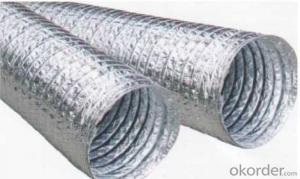When it comes to home improvement or HVAC systems, one of the most important components is the ductwork. It’s not just about the air quality, but also the energy efficiency and overall comfort of your living space. That’s where R6 Flexible Duct comes into play. It’s a game-changer for many homeowners and contractors alike. Let’s dive into the world of R6 Flexible Duct and explore its specifications, installation process, and why it’s such a popular choice.
The Basics: What is R6 Flexible Duct?
R6 Flexible Duct is a type of air duct made from flexible materials that can be easily bent and manipulated to fit into various spaces. It’s designed to connect your HVAC system to the vents or diffusers in your home or office. Unlike rigid ducts, R6 Flexible Duct is more adaptable and can be a lifesaver in tight spots or areas with complex layouts.
Why Choose R6 Flexible Duct?
There are several reasons why R6 Flexible Duct has become a favorite among professionals and DIY enthusiasts. Here are some of the key benefits:
– Adaptability: As mentioned earlier, the flexibility of R6 Flexible Duct allows it to be easily installed in areas where rigid ducts just won’t fit.
– Cost-Effectiveness: It’s generally more affordable than rigid ducts, making it an attractive option for those on a budget.
– Energy Efficiency: Properly installed R6 Flexible Duct can help maintain consistent airflow, reducing energy waste and lowering your utility bills.
– Easy Installation: The ease of installation is a major plus, especially for those who prefer a quick and hassle-free process.
– Customizability: With R6 Flexible Duct, you can create custom lengths and shapes to fit your specific needs.
Specifications to Keep in Mind
Before you decide to use R6 Flexible Duct, it’s important to understand its specifications to ensure it’s the right fit for your project. Here are some key specs to consider:
– Material: R6 Flexible Duct is typically made from a combination of materials, including polyester, aluminum foil, and steel wire helix reinforcement.
– Thickness: The thickness of the duct can vary, but it’s usually around 0.5 to 1 millimeter, providing a balance between flexibility and durability.
– Sizes: R6 Flexible Duct comes in a variety of sizes, ranging from 2 inches to 14 inches in diameter, catering to different HVAC system requirements.
– Insulation: Some R6 Flexible Ducts are insulated, which can help reduce heat loss or gain, further improving energy efficiency.
– Fire Resistance: It’s crucial to choose a duct that meets fire safety standards, ensuring the safety of your home or office.
The Installation Process: A Step-by-Step Guide
Now that you know the basics and the benefits of R6 Flexible Duct, let’s walk through the installation process. Here’s a simple guide to help you get started:
1. Planning: Begin by planning the layout of your ductwork. Consider the location of your HVAC system, vents, and any obstacles that may be in the way.
2. Measuring: Measure the distances and angles needed for your ductwork. This will help you determine the amount of R6 Flexible Duct you’ll need.
3. Cutting: Cut the R6 Flexible Duct to the appropriate lengths using a utility knife or duct cutter. Be sure to make clean, straight cuts for a better fit and seal.
4. Connecting: Connect the duct sections using duct tape or clamps, ensuring a secure and airtight seal.
5. Securing: Secure the ducts in place using duct mastic or straps. This will prevent them from sagging or moving over time.
6. Insulating: If your R6 Flexible Duct is not pre-insulated, consider adding insulation to reduce heat transfer and improve energy efficiency.
7. Testing: Once everything is installed, test your system to ensure proper airflow and that there are no leaks.
Common Challenges and How to Overcome Them
While R6 Flexible Duct is generally easy to work with, you may encounter some challenges during installation. Here are a few common issues and tips on how to handle them:
– Kinks and Crushes: Avoid kinking or crushing the duct as it can restrict airflow. If this happens, you may need to replace the damaged section.
– Leaks: Check for leaks after installation by feeling for cold or hot spots along the ducts. Use mastic or additional tape to seal any leaks you find.
– Proper Support: Ensure that your ducts are properly supported to prevent sagging, which can lead to uneven airflow and increased strain on your HVAC system.
– Fire Safety: Always follow fire safety guidelines and regulations when installing R6 Flexible Duct.
The Future of R6 Flexible Duct
As technology advances, we can expect to see improvements in the materials and manufacturing processes of R6 Flexible Duct. This could lead to even greater energy efficiency, durability, and ease of installation. Keep an eye out for new developments in this field, as they may offer exciting opportunities for your next project.
Wrapping Up
R6 Flexible Duct is a versatile and cost-effective solution for your HVAC system or home improvement project. By understanding its specifications, benefits, and installation process, you can make an informed decision on whether it’s the right choice for you. Remember to always prioritize safety and efficiency when working with any type of ductwork. Happy improving!

